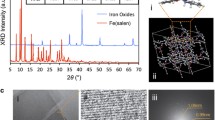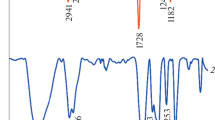Abstract
This work presents the synthesis of magnetite nanoparticle (MNP) coated with poly(N,N-diethylaminoethyl methacrylate)-b-poly(N-isopropyl acrylamide-st-thiolactone acrylamide) (PDEAEMA-b-P(NIPAAm-st-TlaAm) copolymer and its use in controlled drug release and bio-conjugation. TlaAm units in the copolymer were ring-opened with various alkyl amines to form thiol groups (-SH), followed by thiol-ene coupling reactions with acrylamide-coated MNP and then quaternized to obtain cationic copolymer-MNP assemblies (the size < 200 nm/cluster). The use of alkyl amines having various chain lengths (e.g., 1-propylamine, 1-octylamine, or 1-dodecylamine) in the nucleophilic ring-opening reactions of the thiolactone rings affected their magnetic separation ability, water dispersibility, and release rate of doxorubicin model drug. In all cases, when increasing the temperature, they showed a thermo-responsive behavior as indicated by the decrease in hydrodynamic size and the accelerated drug release rate. These copolymer-MNP assemblies could be used as a novel platform with thermal-triggering controlled drug release and capability for adsorption with any negatively charged biomolecules.

MNP coated with multi-functional PDEAEMA-b-P(NIPAAm-st-TlaAm) copolymer and its proposed drug release









Similar content being viewed by others
References
Bischofberger I, Trappe V (2015) New aspects in the phase behaviour of poly-N-isopropyl acrylamide: systematic temperature dependent shrinking of PNiPAM assemblies well beyond the LCST. Sci Rep 5:15520–15529
Braunecker WA, Matyjaszewski K (2007) Controlled/living radical polymerization: features, developments, and perspectives. Prog Polym Sci 32:93–146
Chen J-T, Ahmed M, Liu Q, Narain R (2012) Synthesis of cationic magnetic nanoparticles and evaluation of their gene delivery efficacy in Hep G2 cells. J Biomed Mater Res A 100A:2342–2347
Chen Y, Espeel P, Reinicke S, Du Prez FE, Stenzel MH (2014) Control of glycopolymer nanoparticle morphology by a one-pot, double modification procedure using thiolactones. Macromol Rapid Commun 35:1128–1134
Chen L, Zhang H, Li L, Yang Y, Liu X, Xu B (2015) Thermoresponsive hollow magnetic microspheres with hyperthermia and controlled release properties. J Appl Polym Sci 132:42617
Du H, Wickramasinghe R, Qian X (2010) Effects of salt on the lower critical solution temperature of poly (N-isopropylacrylamide). J Phys Chem 114:16594–16604
Espeel P, Du Prez FE (2015) One-pot multi-step reactions based on thiolactone chemistry: a powerful synthetic tool in polymer science. Eur Polym J 6:247–272
Espeel P, Goethals F, Du Prez FE (2011) One-pot multistep reactions based on thiolactones: extending the realm of thiol-ene chemistry in polymer synthesis. J Am Chem Soc 133:1678–1681
Espeel P, Goethals F, Stamenovi MM, Petton L, Du Prez FE (2012) Double modular modification of thiolactone-containing polymers: towards polythiols and derived structures. Polym Chem 3:1007–1015
Gandhi A, Paul A, Sen OS, Sen KK (2015) Studies on thermoresponsive polymers: phase behaviour, drug delivery and biomedical applications. Asian J Pharm Sci 10:99–107
Hill MR, Carmean RN, Sumerlin BS (2015) Expanding the scope of RAFT polymerization: recent advances and new horizons. Macromolecules 48:5459–5469
Hu Y, Meng L, Niu L, Lu Q (2013) Highly cross-linked and biocompatible polyphosphazene-coated superparamagnetic Fe3O4 nanoparticles for magnetic resonance imaging. Langmuir 29:9156–9163
Huang L, Liu M, Mao L, Xu D, Wan Q, Zeng G, Shi Y, Wen Y, Zhang X, Wei Y (2017) Preparation and controlled drug delivery applications of mesoporous silica polymer nanocomposites through the visible light induced surface-initiated ATRP. Appl Surf Sci 412:571–577
Leung KCF, Lee S, Wong C, Chak C, Lai JMY, Zhu X, Wang YJ, Wang YXJ, Cheng CHK (2013) Nanoparticle–DNA–polymer composites for hepatocellular carcinoma cell labeling, sensing, and magnetic resonance imaging. Methods 64:315–321
Li Y, Zhang X, Cheng H, Kim G, Cheng S, Zhuo R (2006) Novel stimuli-responsive micelle self-assembled from Y-shaped P(U-Y-NIPAAm) copolymer for drug delivery. Biomacromolecules 7:2956–2960
Lim J, Yeap SP, Che HX, Low SC (2013) Characterization of magnetic nanoparticle by dynamic light scattering. Nanoscale Res Lett 8:381–394
Liu P, Luo Q, Guan Y, Zhang Y (2010) Drug release kinetics from monolayer films of glucose-sensitive microgel. Polymer 51:2668–2675
Lowe AB (2010) Thiol-ene “click” reactions and recent applications in polymer and materials synthesis. Polym Chem 1:17–36
Machida N, Inoue Y, Ishihara K (2014) Phospholipid polymer-coverd magnetic nanoparticles for tracking intracellular molecular reaction. Trans Mat Res Soc Japan 39:427–430
Maeda Y, Mochiduki H (2004) Hydration changes during thermosensitive association of a block copolymer consisting of LCST and UCST blocks. Macromol Rapid Commun 25:1330–1334
Mahmoud WE, Bronstein LM, Al-Hazmi F, Al-Noaiser F, Al-Ghamdi AA (2013) Development of Fe/Fe3O4 core-shell nanocubes as a promising magnetic resonance imaging contrast agent. Langmuir 29:13095–13101
Matyjaszewski K (2012) Atom transfer radical polymerization (ATRP): current status and future perspectives. Macromolecules 45:4015–4039
Meerod S, Rutnakornpituk B, Wichai U, Rutnakornpituk M (2015) Hydrophilic magnetic nanoclusters with thermo-responsive properties and their drug controlled release. J Magn Magn Mater 392:83–90
Mekkapat S, Thong-On B, Rutnakornpituk B, Wichai U, Rutnakornpituk M (2013) Magnetic core–bilayer shell complex of magnetite nanoparticle stabilized with mPEG–polyester amphiphilic block copolymer. J Nanopart Res 15:2051–2062
Moad G, Rizzardo E, Thang SH (2008) Radical addition fragmentation chemistry in polymer synthesis. Polymer 49:1079–1131
Patil SS, Wadgaonkar PP (2017) Temperature and pH dual stimuli responsive PCL-b-PNIPAAm block copolymer assemblies and the cargo release studies. J Polym Sci A Polym Chem 55:1383–1396
Prabha G, Raj V (2016) Preparation and characterization of polymer nanocomposites coated magnetic nanoparticles for drug delivery applications. J Magn Magn Mater 408:26–34
Qin S, Qin D, Ford WT, Resasco DE, Herrera JE (2004) Functionalization of single-walled carbon nanotubes with polystyrene via grafting to and grafting from methods. Macromolecules 37:752–757
Qu Y, Li J, Ren J, Leng J, Lin C, Shi D (2014) Enhanced magnetic fluid hyperthermia by micellar magnetic nanoclusters composed of MnxZn1-xFe2O4 nanoparticles for induced tumor cell apoptosis. ACS Appl Mater Interfaces 6:16867–16879
Reinicke S, Espeel P, Stamenović MM, Du Prez FE (2013) One-pot double modification of P(NIPAAm): a tool for designing tailor-made multiresponsive polymers. ACS Macro Lett 2:539–543
Rodkate N, Rutnakornpituk M (2016) Multi-responsive magnetic microsphere of poly(N-isopropylacrylamide)/carboxymethylchitosan hydrogel for drug controlled release. Carbohydr Polym 151:251–259
Sahoo B, Devi KSP, Banerjee R, Maiti TK, Pramanik P, Dhara D (2013) Thermal and pH responsive polymer-tethered multifunctional magnetic nanoparticles for targeted delivery of anticancer drug. ACS Appl Mater Interfaces 5:3884–3893
Sciannamea V, Jérôme R, Detrembleur C (2008) In-situ nitroxide-mediated radical polymerization (NMP) processes: their understanding and optimization. Chem Rev 108:1104–1126
Singh LP, Srivastava SK, Mishra R, Ningthoujam RS (2014) Multifunctional hybrid nanomaterials from water dispersible CaF2:Eu3+, Mn2+ and Fe3O4 for luminescence and hyperthermia application. J Phys Chem C 118:18087–18096
Stamenovi MM, Espeel P, Van Camp V, Du Prez FE (2011) Norbornenyl-based RAFT agents for the preparation of functional polymers via thiol-ene chemistry. Macromolecules 44:5619–5630
Trongsatitkul T, Budhlall BM (2013) Microgels or microcapsules? Role of morphology on the release kinetics of thermoresponsive PNIPAm-co-PEGMa hydrogels. Polym Chem 4:1502–1516
Ulbrich K, Holá K, Šubr V, Bakandritsos A, Tuček J, Zbořil R (2016) Targeted drug delivery with polymers and magnetic nanoparticles: covalent and noncovalent approaches, release control, and clinical studies. Chem Rev 116:5338–5431
Wang B, Li B, Zhao B, Li CY (2008) Amphiphilic janus gold nanoparticles via combining “solid-state grafting-to” and “grafting-from” methods. J Am Chem Soc 130:11594–11595
Wang C, Xu H, Liang C, Liu Y, Li Z, Yang G, Cheng L, Li Y, Liu Z (2013) Iron oxide @ polypyrrole nanoparticles as a multifunctional drug carrier for remotely controlled cancer therapy with synergistic antitumor effect. ACS Nano 7:6782–6795
Willcock H, O’Reilly RK (2010) End group removal and modification of RAFT polymers. Polym Chem 1:149–157
Acknowledgements
The authors acknowledge the Thailand Research Fund (TRF)(RSA5980002) for financial support. MR thanks the National Research Council of Thailand (NRCT) (R2561B086) for the supports. SP thanks The Royal Golden Jubilee PhD Program (PhD/0210/2556) for the scholarship.
Funding
This study was funded by The Thailand Research Fund (TRF) (RSA5980002), the National Research Council of Thailand (NRCT) (R2561B086), and the Royal Golden Jubilee PhD Program (PhD/0210/2556).
Author information
Authors and Affiliations
Corresponding author
Ethics declarations
Conflict of interest
The authors declare that they have no conflict of interest.
Rights and permissions
About this article
Cite this article
Paenkaew, S., Rutnakornpituk, M. Effect of alkyl chain lengths on the assemblies of magnetic nanoparticles coated with multi-functional thiolactone-containing copolymer. J Nanopart Res 20, 193 (2018). https://doi.org/10.1007/s11051-018-4295-2
Received:
Accepted:
Published:
DOI: https://doi.org/10.1007/s11051-018-4295-2




